Lenovo ThinkStation P300 Workstation Review: Haswell plus Quadro
by Ian Cutress on November 4, 2014 10:00 AM EST- Posted in
- Systems
- Intel
- Lenovo
- Seagate
- Quadro
- Workstation
- Haswell
- desktops
- Enterprise
- NVIDIA
System Benchmarks
Power Consumption
Power consumption was tested on the system at the wall. This method of power reading allows us to compare the power management of the UEFI and the board to supply components with power under load, and includes typical PSU losses due to efficiency. These are the real world values that consumers may expect from a typical system (minus the monitor).
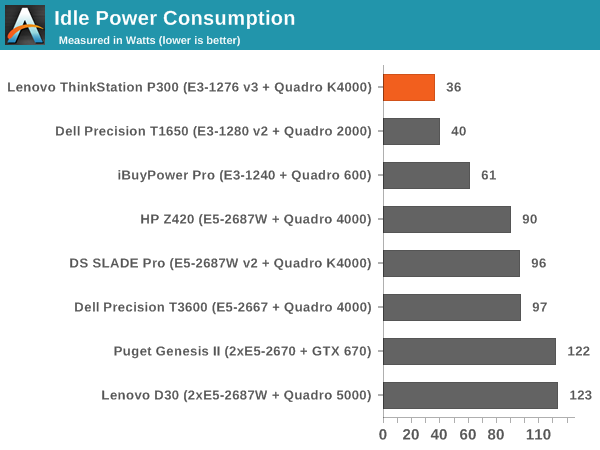
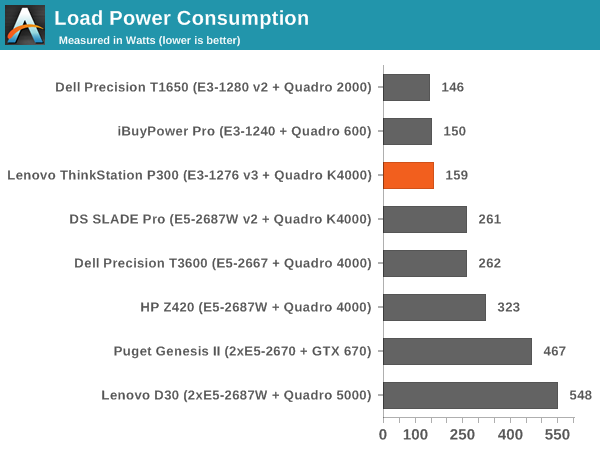
Power consumption on the P300 was pretty amazing due to the very efficient power supply used.
Windows 7 POST Time
Different motherboards have different POST sequences before an operating system is initialized. A lot of this is dependent on the board itself, and POST boot time is determined by the controllers on board (and the sequence of how those extras are organized). As part of our testing, we look at the POST Boot Time using a stopwatch. This is the time from pressing the ON button on the computer to when Windows 7 starts loading. (We discount Windows loading as it is highly variable given Windows specific features.)
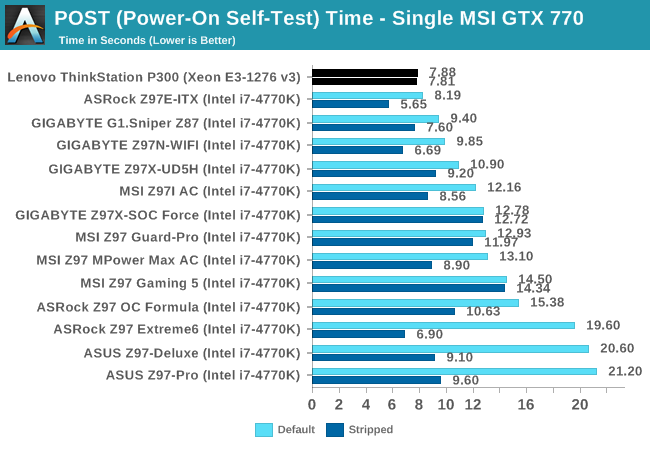
POST Times were also right on the money, giving some of our best POST times ever.
Rightmark Audio Analyzer 6.2.5
Rightmark:AA indicates how well the sound system is built and isolated from electrical interference (either internally or externally). For this test we connect the Line Out to the Line In using a short six inch 3.5mm to 3.5mm high-quality jack, turn the OS speaker volume to 100%, and run the Rightmark default test suite at 192 kHz, 24-bit. The OS is tuned to 192 kHz/24-bit input and output, and the Line-In volume is adjusted until we have the best RMAA value in the mini-pretest. We look specifically at the Dynamic Range of the audio codec used on board, as well as the Total Harmonic Distortion + Noise.


Unfortunately the audio performance for SNR was rock bottom due to the laptop-class codec used. THD+N was reasonable, although just above the median.
USB Backup
For this benchmark, we transfer a set size of files from the SSD to the USB drive using DiskBench, which monitors the time taken to transfer. The files transferred are a 1.52 GB set of 2867 files across 320 folders – 95% of these files are small typical website files, and the rest (90% of the size) are small 30 second HD videos. In an update to pre-Z87 testing, we also run MaxCPU to load up one of the threads during the test which improves general performance up to 15% by causing all the internal pathways to run at full speed.

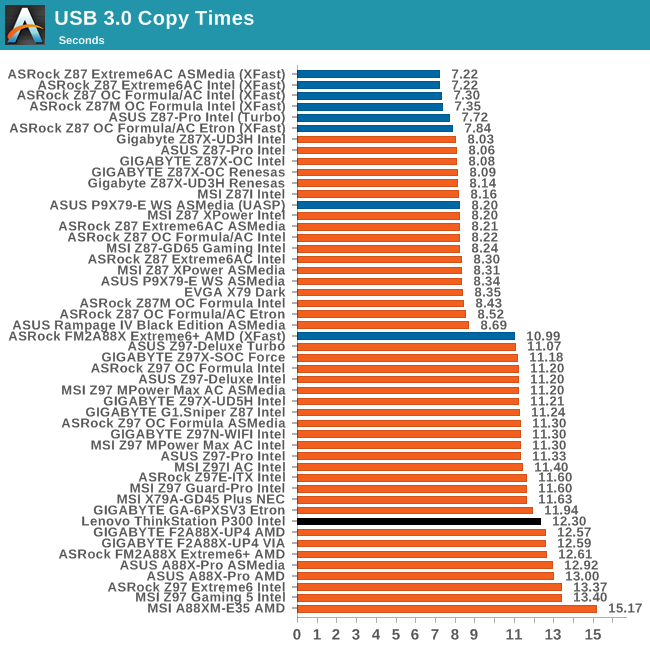
USB Performance seemed to lag behind the other motherboards that also accept Haswell CPUs.
DPC Latency
Deferred Procedure Call latency is a way in which Windows handles interrupt servicing. In order to wait for a processor to acknowledge the request, the system will queue all interrupt requests by priority. Critical interrupts will be handled as soon as possible, whereas lesser priority requests such as audio will be further down the line. If the audio device requires data, it will have to wait until the request is processed before the buffer is filled.
If the device drivers of higher priority components in a system are poorly implemented, this can cause delays in request scheduling and process time. This can lead to an empty audio buffer and characteristic audible pauses, pops and clicks. The DPC latency checker measures how much time is taken processing DPCs from driver invocation. The lower the value will result in better audio transfer at smaller buffer sizes. Results are measured in microseconds.
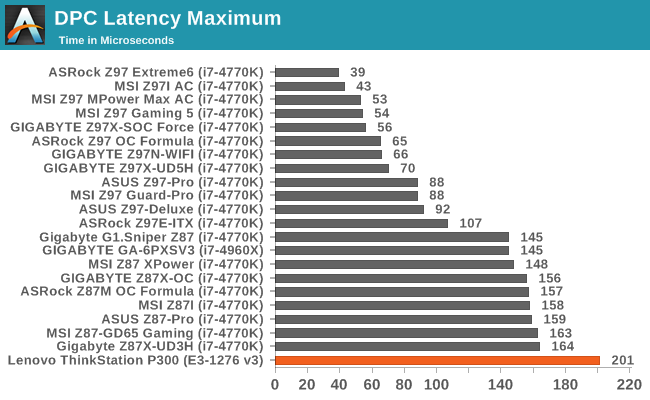
DPC Latency for the system was also relatively poor. Intel's 9-series made us rethink the milestone in terms of a good level of performance from 200 microseconds to 100 microseconds. The P300 hits the old target rather than the new one.










55 Comments
View All Comments
Pork@III - Tuesday, November 4, 2014 - link
Only 8GB RAM place on workstation PC in fall of 2014? Poorest IBM! Poor, poor, poor! :Dkissiel - Tuesday, November 4, 2014 - link
Lack of any amount flash storage is even more frightening...MadDuffy - Tuesday, November 4, 2014 - link
The SSHD storage is hybrid solid state and traditional.jimbo2779 - Tuesday, November 4, 2014 - link
The SSHD is hardly a patch on a real SSD store. I could not imagine running a WS on anything less than an SSD on SATA III.akula2 - Wednesday, November 5, 2014 - link
I use lot of Samsung 850 Pros and SanDisk 960GB ExtremePro SSDs. But this Mushkin Scorpion Deluxe 960GB PCIe SSD decimates those models (PCIe 2.0 x8 interface).Hence, I shall buy more for the upcoming X99 high-end; for ultra builds (Xeons), I'm pondering on Intel's NVMe enterprise solution (1.2TB SSD). Price is justified because it offers literally ultra performance.
Samus - Wednesday, November 5, 2014 - link
Sloppy. An elitedesk it is not.noelbonner - Tuesday, November 11, 2014 - link
Yes it's sloppy and poorly ranked in CONSUMER BASED rankings, see http://is.gd/L7YVjK for example.testbug00 - Tuesday, November 4, 2014 - link
which does about nothing. I have one. Unless they completely redesigned how they worked in the last 3 years (which, I doubt).At this point, personally, I just wish I could use the SSD in my hybrid drive to boot the OS and maybe 1-2 other things... But, nope =[
chizow - Tuesday, November 4, 2014 - link
I have an SSHD and while it is definitely not SSD speeds for sustained transfers or random I/O, it does a really nice job in two areas:1) Cached file information. Anyone dealing with video editing will appreciate this. The video info and previews load much faster than a traditional HDD due to the SSD cache.
2) Overall operating temps. Possibly because they don't need to spin up as often, my Seagate SSHD is cool to the touch while my retired WD Blacks could probably cause a burn.
They also have higher capacities available like a traditional HDD would making them pretty affordable overall.
Samus - Thursday, November 6, 2014 - link
I agree SSHD's are great alternatives to SSD's in certain machines. But they do not belong in laptops (honestly any mobile device should have no moving parts outside of a fan...for obvious durability reasons) and they don't belong in workstations where there is space for a SSD boot drive and a HDD storage drive.SSHD's make a lot more sense in home PC's where media storage is common and common HDD performance is a huge bottleneck. Many home users simply don't want to deal with two drives/partitions and most systems these days only have one drive bay, such as AIO's.